(clicking on the pictures should open them larger in a new window)
We spent last night at the Safety Rest Area El Paso County Westbound just off of I-10 near Fabens, Texas. After spending seven nights at the Maverick RV Ranch in Lajitas, TX Tom drove 284 miles to get us here. The temperature when we woke up this morning was 31 degrees brrrrrr.....is all I can say. In a few hours we will be in New Mexico where we will spend the next two days.
 |
Sunset looking out over I-10 on November 11, 2022
(If you click enough pictures you do get one without
a traffic blur.) |
Sunday, November 6, 2022


FORT LEATON STATE HISTORIC SITE. Fort Leaton State Historic Site is on Farm Road 170, the Rio Grande, and what has been called the Chihuahua Trail five miles southeast of Presidio in Presidio County. At various times Fort Leaton was called Old Fortin, El Fortin, and Fortin. Because the area around the fort has been continuously occupied since 1500 B.C., tradition has given it a romantic past. Fort Leaton has been named as the site of both El Apostol Santiago, a Spanish mission established in 1684 and rebuilt in 1773, and as Presidio del Norte de la Junta de los Rios, built in 1760. However, recent archeological investigations at Fort Leaton do not substantiate these claims and set the site's earliest possible human occupation as the 1820s. Indications suggest that the building was used from the 1840s to the 1920s.
The structure, called the largest adobe structure in Texas, was probably built by Juan Bustillos as his home in the 1830s. In August 1848 Ben Leaton, a Chihuahua Trail freighter and the first Anglo-American farmer in Presidio County, bought the property from Bustillos. Leaton established Fort Leaton as his home, trading post, and private fort. It was the first seat of the unorganized Presidio County. The L-shaped fort was built with the long side running east and west, parallel to the river, for 200 feet. The base of the building measured 140 feet. A crenellated parapet surrounded the rooms, allowing a stockade for animals and fortification for the site. Large doors gave access to teams and wagons.
Leaton died between January 1 and August 15, 1851, leaving his wife with large debts. The fort passed to John Burgess, who held the mortgage. Burgess's descendants lived at Fort Leaton into the 1920s. After the Burgesses left, the fort fell into disuse. In 1934 T. C. Mitchell and the Marfa State Bank acquired the old structure and donated it to the county as a historic site. Restoration work began under a county works project, but inadequate funding prevented its completion. A. C. Skidmore bought the property later and donated it to the state. In 1968 it became Fort Leaton State Historic Site.
Archeological work done in 1969 revealed that the adobe walls were built in three phases. Excavations in 1971 uncovered nine new rooms, a ramada, a corral, various living floors, and the limits of the north wall. The site has been restored to conform with the archeological findings.
It was added to the National Register of Historic Places listings in Presidio County, Texas on June 18, 1973. It opened to the public in 1978. (Information found on the Texas State Historical Association Site and other history sites.)
 |
| Mexican Free-tailed Bats call this Fort home. |
 |
| The Courtyard. |
 |
| This display is in the Servant's Quarters. |
 |
The Corral
Notice the fence made out of ocotillos
in the upper right picture. |
The cart in the above picture is called a Carretas. The wheel on the replica is six feet tall. When fully loaded they were so heavy it took 10 to 12 oxen to pull one.
 |
Walking through one of the doorways, bottom right, shows
the thickness of the walls. Upper left, door and ceiling to one
of the rooms. Upper right a window, bottom left shade cover
out in the corral area. |
 |
| Pictures of the various rooms |
 |
| Tom took |
 |
| throughout the Fort. |
's
 |
First built as a chapel by the Burgess family in the 1920's,
the mausoleum contains the remains of John D. Burgess
and Thomasa Baeza Burgess. |
After spending time at the Fort Leaton we turned East on FM-170 and headed back home. The ride back was just as beautiful as the ride to Presidio in the morning. Something we only caught small glances of in the morning was the Rio Grande River on the way back, this afternoon, we had time to stop and see more than a quick glance.
 |
| There are Ocotillo every where I look. |
 |
We drove in here.
We both thought the information on the sign was interesting. |
 |
Tom taking some pictures
near the boat ramp. |
 |
| We are looking across at Mexico. |
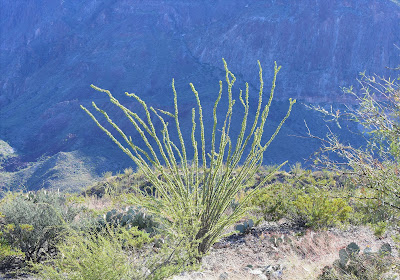 |
We were stopped waiting for a green light to cross a bridge
being repaired. I looked right, saw this guy, and could not
resist taking a picture. |
 |
| There are tables under the Tepees. |
 |
| Our last look at the Rio Grande River for today. |
This was a beautiful ride both ways. As I mentioned in the last post the road dipped and curved and with every turn the views were breathtaking. We are glad we took the opportunity to drive along the El Camino del Rio “The River Road” .
We are so glad you stopped by!
If you have time to leave a comment we would enjoy hearing from you.




































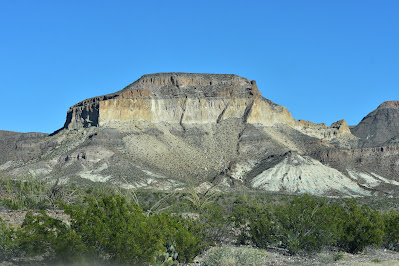



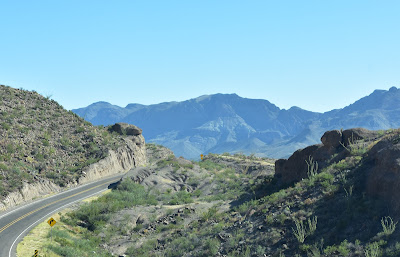







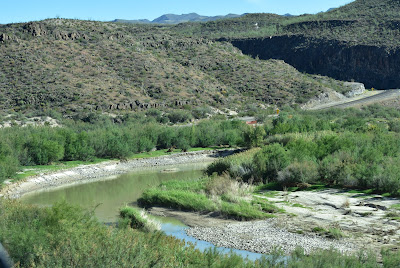






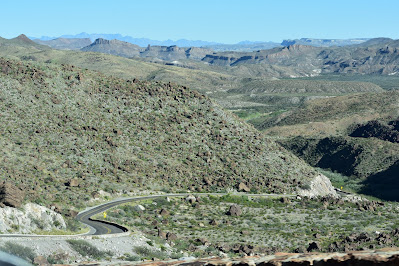










I trust you made it to New Mexico? :)
ReplyDeleteYes we did...😊
DeleteWow, some amazing views.
ReplyDeleteCart was interesting! I like the ocotillo fence, very interesting idea.
Deb
Those were some big wheels on that cart. I wish I had thought to have Tom go and stand by it for a picture.
DeleteBeautiful drive and the history of Fort Leaton is interesting. The Rio Grande River looks beautiful.
ReplyDeleteWe agree with everything you said! 😎
DeleteIt's fun to imagine that fort back in the day.
ReplyDeleteI think it must have been a busy place.
DeleteGlad to see you are enjoying the history of a new adventure. Wishing we were there.
ReplyDeleteBe Safe and Enjoy!
It's about time.
We did enjoy that area. Wish you and Kathy were coming out, also.
Delete